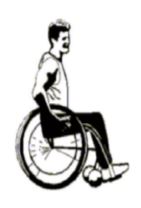Interacting with People with Physical Disabilities
Mobility and physical disabilities also fall along a continuum, from people who have mild to significant limitations which can limit movement, strength, and endurance.
-
If shaking hands is appropriate, do so. People with limited hand use or who use prosthesis can usually shake hands. If people have no arms, lightly touch their shoulder.
-
Leaning or hanging onto a person’s wheelchair is similar to leaning or hanging onto a person and is generally considered annoying. The chair is part of the personal body space of the person who uses it. Stand next to the person’s wheelchair, rather than leaning or holding onto it.
-
When pushing people using a wheelchair, let them know that you are ready to push. Be aware of the distance between the chair and other people to avoid clipping their heels. Avoid sudden turns of speed changes and carefully watch for changes in levels and pavement cracks and potholes. When moving up or down steps, steep ramps, or curbs, ask wheelchair users how they would like to proceed.
-
When speaking to a person using a wheelchair or scooter for more than a few minutes, try to find a seat or kneel so the two of you are at the same eye level.
-
When giving directions, consider and be specific about distance, weather conditions, and barriers such as stairs, steep hill, ramps, and construction areas.
-
Ask for permission before moving someone’s cane, crutches, walker, or wheelchair.


User Comments/Questions
Add Comment/Question